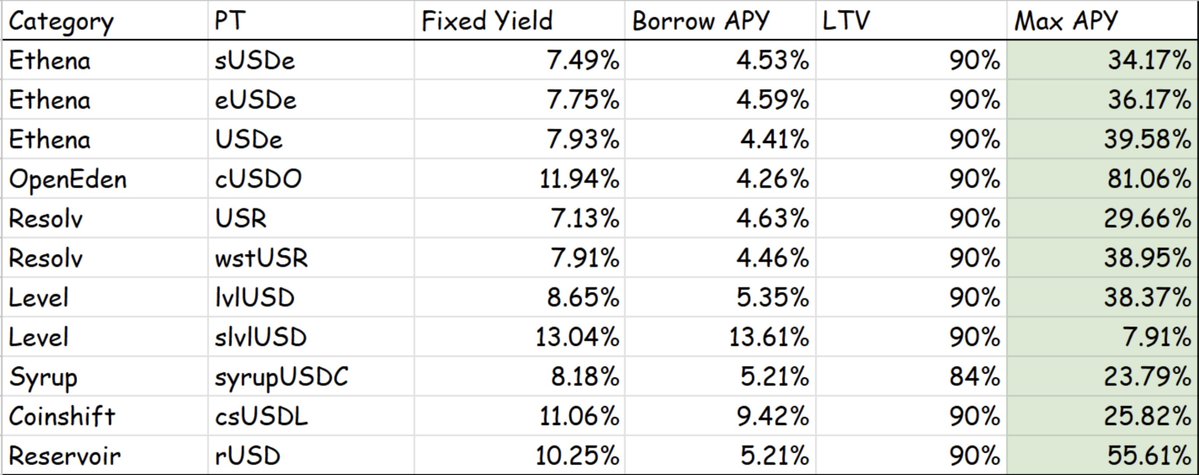🥳Pendle PT leveraged loop lending yields are indeed impressive, but make sure to understand your investment content and manage your own risk control.
Grandma knocks on the blackboard:
@BTW0205 Teacher Wu's advanced Pendle strategy review
There’s no such thing as a free lunch, so please DYOR seriously!

🧐Advanced Pendle Arbitrage Techniques: Doubling Returns with Loop Lending|Using Ethena PT as an Example——
Recently, I noticed that @ethena_labs' PT assets have been listed on Aave as collateral, and the quota was almost instantly used up. Yes, many DeFi players have likely discovered a secret:
Pendle + lending protocols can create a low-risk leveraged structure. If executed properly, the annualized return can reach 30%.
But this isn’t just simple leverage; it’s a calculated strategy to earn fixed income + airdrop points + structural arbitrage, turning Pendle’s loop lending strategy into a new round of "smart money games."
In my last post, many people DM’d me about this. Today, let’s dive into @pendle_fi’s loop lending strategy——
1⃣ Strategy Principle: Use PT as Collateral to Amplify Fixed Income
Pendle separates yield rights and principal, where PT = principal token, and YT = yield token.
The logic of loop lending is straightforward——
You buy Pendle’s stablecoin PT, use it as collateral on Aave, and borrow stablecoins;
Then use the borrowed stablecoins to buy more PT on Pendle—repeat the process to amplify returns.
This forms a closed loop of "Buy PT → Collateralize → Borrow Stablecoins → Buy More PT."
As long as the interest rate spread is positive (yield > borrowing cost), you can leverage to earn fixed income.
2⃣ Practical Steps: 5 Steps to Master Pendle PT Loop Lending
Using PT-sUSDe as an example, you start with 1000u, assuming an annualized yield of 7.5% and Aave borrowing cost of 5%.
1) Buy PT-sUSDe:
Go to Pendle and buy PT-sUSDe, making sure to select the maturity date.
2) Deposit PT into Aave V3 as Collateral:
Open Aave V3 and deposit the corresponding PT asset as collateral.
3) Borrow Stablecoins (e.g., USDC, USDT):
Aave provides lending functionality; borrow the amount of stablecoins you can handle (e.g., LTV 70%, borrow 700u).
4) Use Borrowed Stablecoins to Buy More PT:
Return to Pendle to buy more PT, then collateralize and borrow again… forming a loop.
5) Set Loop Count Based on Personal Risk Preference:
It’s generally recommended not to exceed 3 loops (to avoid liquidation risk).
3⃣ Profit Model: How Much Can You Earn with Leveraged Loops?
The income sources from loop lending mainly include:
✅ Fixed-rate income from PT
✅ Compounding effect from multiple leverage rounds
✅ Potential airdrop points (Pendle + Ethena + Aave, if available)
Assume:
PT annualized yield = 7.5%
Aave borrowing cost = 5%
Two loops, i.e., leverage multiplier = 2.5x
Net income = (7.5% × 2.5) - (5% × 1.5) ≈ 11.5% annualized
Even in a low spread environment (7.5% vs 5%), leveraging loops can still boost stablecoin yields to over 10%, making it very suitable for conservative players to enhance returns using structured strategies.
If you use other assets with higher PT rates and lower borrowing costs, annualized returns can be even higher, sometimes reaching 70%.
4⃣ Risk Warning: Is This Risk-Free Arbitrage?
No arbitrage is risk-free. The main risks include:
❗️Price Slippage and Liquidity Issues: Multiple PT purchases may increase slippage.
❗️Interest Rate Fluctuations: Aave’s borrowing rates are variable and may rise, compressing your spread.
❗️LTV and Liquidation Risk: PT, as a non-mainstream collateral, has conservative liquidation parameters. Any PT volatility could trigger liquidation.
❗️Depeg Risk: Although PT is tied to stablecoins, the underlying asset (e.g., sUSDe) may have slight depeg risks.
The most notable risk is liquidation in loop lending.
As the number of loops increases, net income and APR rise, but so does the liquidation risk factor.
Assume the current PT-sUSDe market price is $1.00. In the first loop, there’s almost no liquidation risk (PT price can drop over 12%);
By the third loop, a PT price drop of just 8.5% could trigger liquidation;
In the fourth loop, the liquidation threshold narrows to a mere 6% drop, which is extremely risky.
Increasing the number of loops narrows the risk margin, especially under high leverage, where each additional loop compresses the tolerance space.
Therefore, I recommend a maximum of 1-2 loops. Don’t over-leverage; this is the sweet spot for a high risk-reward balance.
5⃣ Who Is Suitable for Pendle Loop Lending Strategy?
Since loop lending involves multiple rounds of leverage, it does have certain operational thresholds. It’s more suitable for:
✅ Players familiar with DeFi operations and on-chain lending liquidation logic
✅ Conservative leverage enthusiasts interested in stable returns + airdrop incentives
✅ Those willing to monitor collateral status daily or weekly and adjust leverage as needed
❌ Not suitable for beginners who don’t understand liquidation mechanisms
❌ Not suitable for those unable to monitor positions and manage leverage
6⃣ Summary——
Pendle’s stablecoin PT + lending = "Treasury Bonds + Leverage" in DeFi. The loop lending strategy is very similar to the "bond leverage spread" in TradFi, with the most enticing aspect being the stable spread. The logic is the same, just in a different form.
Now is indeed a good window of opportunity, but always remember:
1) All arbitrage involves trading risk for returns.
2) PT-sUSDe, though pegged to stablecoins, still carries risks like discounting, liquidity, interest rate fluctuations, and liquidation.
3) When the market is greedy, leverage is often the last straw that breaks the position.
Understanding the structure, mastering the rhythm, and respecting risks are the three essential lessons for Pendle players. Controlling risks while maximizing returns is the ultimate key to survival!
You can join Pendle’s Chinese community, where there are many current investment strategies to learn from:
Pendle also has detailed Chinese tutorials:

5
23.37K
The content on this page is provided by third parties. Unless otherwise stated, OKX TR is not the author of the cited article(s) and does not claim any copyright in the materials. The content is provided for informational purposes only and does not represent the views of OKX TR. It is not intended to be an endorsement of any kind and should not be considered investment advice or a solicitation to buy or sell digital assets. To the extent generative AI is utilized to provide summaries or other information, such AI generated content may be inaccurate or inconsistent. Please read the linked article for more details and information. OKX TR is not responsible for content hosted on third party sites. Digital asset holdings, including stablecoins and NFTs, involve a high degree of risk and can fluctuate greatly. You should carefully consider whether trading or holding digital assets is suitable for you in light of your financial condition.


